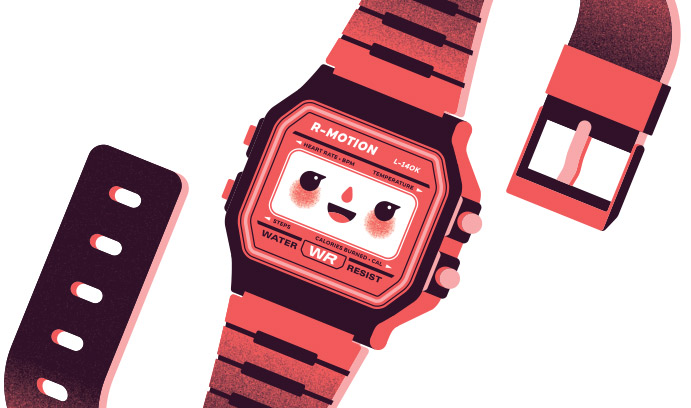A Smarter Way to Work

A team of students at Mountaintop set out to determine if wearable technology could help in evaluating how school principals, teachers and others spend their time and how they interact with their school environments. Illustration by Jordon Cheung.
Inside the cool, cavernous interior of Bay 2 on Lehigh's Mountaintop Campus, six students studied flowcharts and scrawled notes on whiteboards. Outside their roomy, makeshift cubicle, a fluorescent sign proclaiming their mission—Smart Schools—stood like a sentry amidst a sea of similar cubicles and similar markers.
The students set out to determine if wearable technology could help in evaluating how school principals, teachers and others spend their time and how they interact with their school environments. Their work in summer 2016 was part of Lehigh's Mountaintop program, which gives teams of undergraduate and graduate students from a variety of disciplines the freedom to pursue answers to open-ended questions.
"I was really impressed with how this group grew," said Abby Mahone, a graduate student in Educational Leadership who worked with the team. "The students had to teach themselves new skills to accomplish tasks they had never done before."
The team was adapting existing smart-wearable technology and creating mobile and desktop apps that could potentially be used to study school administrators' daily activities and behaviors. Each student brought different talents to the table—coding, cognitive science, design, business skills.
Mahone and her adviser, Craig Hochbein, assistant professor of Educational Leadership in the College of Education, mentored the students and allowed them to formulate their own ideas.
The project extended Hochbein's earlier work in tracking how principals use their time—and how that might correlate with student behavior/emotional risk. The students saw the recent explosion of biometric data-gathering devices as a golden opportunity to learn how the devices can improve the study and management of time use.
"After reviewing over 100 years of principals' time use research, we discovered that the daily activities of principals have been studied in only four ways—one-time surveys, observations, daily logs or event-sampling methodology," Mahone said. "We saw a huge opportunity to use data-collection technologies to improve the study of principals and created the team to explore it as a possibility. The hope is to have created a kit that principals or teachers can wear all year."
The team hoped the project would provide new insights into the challenges of administrators' jobs.
"We know very little about how they react to their environment right now," said Hochbein. "For example, which classrooms and spaces are principals visiting, and how are they reacting to those settings? Is the behavior of the principal influencing the school setting? Context matters, but it's very difficult to quantify how much it matters." The students took advantage of available smart-wearable technology that already accesses daily activities, to be able to examine heart rate and steps and floors climbed, and they conceived and built an app to track locations.
Implications for research
The students wanted to outfit administrators with devices that would provide biometric data, including time spent walking, standing and sitting. The challenge was to be able to integrate data from multiple sources to paint a detailed, objective picture of how individuals respond physically and mentally, minute by minute, to their surroundings.
The students also developed the mobile and desktop applications that would allow principals to be contacted at random intervals with set questions to determine what they were doing and at "critical points," such as when the technology indicated heart rates were up. More research is needed to determine "critical points," Mahone said.
To find a technology that would yield data without being obtrusive to users, the students tried out a variety of wearable devices on themselves, other Mountaintop students and faculty. They narrowed their choices to three.
"One surprising thing we found was that not all the devices do what they say they will," said bioengineering major Dasom Ko '17. The students learned to be critical of technology while using it for a specific purpose. "Our kit of sensors had to make sense of what we needed to learn from educators," said Karen Huang '17, a cognitive science and design major.
The group also worked on software that integrates data from wearable devices with principals' answers to questions that are pinged to them. Common methods of data collection have used logs or beepers to record how people spend their time, but smart-wearable technology eliminates observer bias to yield more comprehensive data, Hochbein said.
Jordan Alam '19, a computer science and business major, created the mobile app that sends the queries to participants and allows them to input their answers.
"We want to know what the principal was doing [at a particular moment]," he said. Data return is more robust when an event-sampling methodology is used. Multiple forms of data come in at regular intervals—location, heart rate, position (such as standing or sitting). Adding data, such as when the program pings a principal for more information, provides a richer source of information, said Mahone.
Computer engineering student Sudipta Chowdhury '17 wrote the code for software to integrate multiple types of data into a single cohesive format. "We collected all the raw data in a database and had to make sure it could work with different devices so we could analyze it later," he said.
Dan Kramer '16, a computer science student, looked to take advantage of a school's WiFi network to figure out a principal's location at any given time. By grabbing the IDs of WiFi access points, he said, "we can see how much time they spend in a certain room or place."
Mahone said the project has "huge implications for education research."
Story by Manasee Wagh
Posted on:




